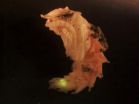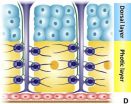Work shines light on Hox genes responsible for firefly lantern development
Notion that Hox genes acquire new roles quickly, without compromising old ones, is novel
2014-03-19
(Press-News.org) It's difficult to identify a single evolutionary novelty in the animal kingdom that has fascinated and intrigued mankind more than the lantern of the firefly. Yet to this day, nothing has been known about the genetic foundation for the formation and evolution of this luminescent structure.
But now, new work from a former Indiana University Bloomington graduate student and his IU Ph.D. advisor offers for the first time a characterization of the developmental genetic basis of this spectacular morphological novelty -- the firefly's photic organ -- and the means by which this beetle successfully uses ancient and highly conserved regulatory genes to form its lantern.
"Our study demonstrates unprecedented roles for two Hox genes," said Armin Moczek, associate professor in the College of Arts and Sciences' Department of Biology and co-author on the paper with his former Ph.D. student Matthew Stansbury, now a postdoc at the University of Arizona. "These genes have been highly conserved over very long evolutionary times to lay out the basic body forms of so many animals, from humans to flies. Our study now shows that on top of that, these Hox genes have recently acquired control over important aspects of lantern development."
Hox genes are famous for specifying body regions and their boundaries, such as the head, thorax and abdomen of insects, or the cervical, thoracic and lumbar vertebrae of mammals. Hox genes are also famous for specifying which appendage will form on a given segment, such as a mouthpart in the head and a wing on the thorax, as well as specific modifications of these appendages: The beetle's forewing is a hardened shell rather than membranous due to the actions of a Hox gene, as is the reduction of the fly's hind wing to a tiny balancer organ.
What is nearly unprecedented, however, is that in the case of this beetle belonging to a family of about 2,000 species, the two Hox genes abdominal-A (abd-A) and Abdominal-B (Abd-B), appear to have acquired the ability to regulate an entirely novel, complex organ found nowhere else: the lantern.
"The notion that Hox genes can simply acquire new responsibilities quickly, especially without compromising old ones, is rather novel," Moczek said. "This is one of relatively few examples that show that this indeed occurs in animal evolution."
What Stansbury and Moczek found by down-regulating the function of each of these two genes was that both were required for proper adult photic organ formation.
"In particular, the Abd-B Hox gene was critical to all aspects of photic organ formation, suggesting it has evolved novel lantern-specific regulatory interactions," Moczek said.
They also found that Abd-B repressed abdominal pigmentation in fireflies' photic organs, thereby creating a translucent cuticle that allows the light to escape the body interior. In addition, the sixth and seventh abdominal segments of most insects is ordinarily under the sole purview of abd-A rather than Abd-B. However, it is precisely these segments that house the lantern in fireflies, suggesting the possibility of an anterior expansion of the domain of Abd-B function. That's a big deal because Hox genes, given their hugely important functions in establishing the basic body plan, normally confine themselves to strict and highly conserved boundaries of expression.
"This is just the beginning," Moczek said. "We want to know what are the target genes with which abd-A and Abd-B interact to form the organ; we want to get data on exactly when and where a given gene product is active; and we want to learn more about how the adult organ evolved from the larval organ, a much simpler structure located on yet another segment," he added.
Moczek is no stranger to investigating novel traits, and the new work presents another example within his body of work that the possibility exists that Hox-gene mediated innovation -- true, unique innovation -- is more widespread than generally thought. Another example of this is beetle horns, one of Moczek's primary areas of research: The horns of beetles are a novel trait that lack correspondence to other traits in beetles or insects. Work conducted by his former graduate student Bethany Wasik found that the positioning and growth of horns that come out of the thorax of beetles is regulated in part by the Hox gene Sex-combs-reduced.
And as novel traits are well-understood by Moczek, Hox genes are especially close to IU's Department of Biology: The homeobox (Hox is the abbreviation) DNA sequence was discovered in 1983 by students in the laboratory of IU Distinguished Professor of Biology Thom Kaufman.
"This study is the first of its kind on these organisms and this structure, and we hope more than anything opens the door for future work on these charismatic insects," Moczek said.
INFORMATION:
"The function of Hox and appendage-patterning genes in the development of an evolutionary novelty, the Photuris firefly lantern," by Matthew Stansbury, University of Arizona, and Armin Moczek, Indiana University, was published today in the Proceedings of the Royal Society B.
ELSE PRESS RELEASES FROM THIS DATE:
Winners and losers in globalization of world's economy, health and education
2014-03-19
Globalization has made the world a better and more equal place for many more people than was the case a few decades ago. However, it has also created two well-defined worlds of poor countries and wealthy nations, according to Vanesa Jordá and José María Sarabia of the University of Cantabria in Spain. In an article published in Springer's journal Applied Research in Quality of Life, they studied the distribution of well-being over the last wave of globalization between 1980 and 2011.
Well-being is generally described as the state of being happy, healthy or prosperous. ...
Magnetic behavior discovery could advance nuclear fusion
2014-03-19
ANN ARBOR—Inspired by the space physics behind solar flares and the aurora, a team of researchers from the University of Michigan and Princeton has uncovered a new kind of magnetic behavior that could help make nuclear fusion reactions easier to start.
Fusion is widely considered the ultimate goal of nuclear energy. While fission leaves behind radioactive waste that must be stored safely, fusion generates helium, a harmless element that is becoming scarce. Just 250 kilograms of fusion fuel can match the energy production of 2.7 million tons of coal.
Unfortunately, it ...
Increased risk of relapse omitting RT in early PET scan negative Hodgkin lymphoma
2014-03-19
Interim analysis of the intergroup EORTC-LYSA-FIL 20051 H10 trial published in the Journal of Clinical Oncology indicates an increased risk of early relapse when omitting radiotherapy in early PET scan negative patients with stage I/II Hodgkin's lymphoma. Early outcome, however, was excellent in both arms, and the final analysis should reveal whether these initial findings are maintained over time.
Dr. J.M.M. Raemaekers of the Radboud university medical center Nijmegen, The Netherlands, and central coordinator of the study says, "The standard treatment for patients with ...
Study finds forest corridors help plants disperse their seeds
2014-03-19
A forest in South Carolina, a supercomputer in Ohio and some glow-in-the-dark yarn have helped a team of field ecologists conclude that woodland corridors connecting patches of endangered plants not only increase dispersal of seeds from one patch to another, but also create wind conditions that can spread the seeds for much longer distances.
The idea for the study emerged from modern animal conservation practices, where landscape connectivity – the degree to which landscapes facilitate movement – is being used to counteract the impacts of habitat loss and fragmentation ...
Inflammation mobilizes tumor cells
2014-03-19
Researchers of Ludwig-Maximilians-Universitaet (LMU) in Munich have discovered a novel feedback mechanism that provides a mechanistic link between chronic inflammation and carcinogenesis.
Malignant tumors pose a major threat to survival largely because they shed mobile cells that can form secondary tumors in other tissues. This process requires a fundamental change in the character of cells within the primary tumor, insofar as members of a localized cell mass must be converted into actively migrating cells that invade into the surrounding tissue and blood vessels, and ...
IU, Regenstrief study: New noninvasive colorectal cancer screening tool highly accurate
2014-03-19
INDIANAPOLIS -- An Indiana University and Regenstrief Institute study of nearly 10,000 average-risk, asymptomatic men and women from 90 sites across the United States reports that a multi-target stool DNA test -- a new noninvasive colorectal cancer screening tool that has not yet been approved for sale by the Food and Drug Administration -- detects 92.3 percent of colon cancers, compared to only 73.8 percent of cancers detected by a fecal immunochemical test, the most commonly used noninvasive test today.
Study results were published online March 19 and in the April ...
Earliest evidence of limb bone marrow in the fin of a 370 million year old fish
2014-03-19
This week in the journal Proceedings of the Royal Society B, a team of French and Swedish researchers present the earliest fossil evidence for the presence of bone marrow in the fin of a 370 million-year-old fish.
Long bones, which are found in the limb of tetrapods, are not only important for locomotion and supporting the weight of the body, but also host the bone marrow. The latter plays a major role in haematopoiesis, i.e. the formation of blood cells. In a healthy adult human, about a hundred billion to one trillion new blood cells are produced every day to maintain ...
Internists must play a larger role in managing menopausal symptoms
2014-03-19
New Rochelle, NY, March 19, 2014—The number of menopausal women is projected to reach 50 million by 2020. With changing views on appropriate therapies to control symptoms and new treatments available and on the horizon, most internists lack the core competencies and experience to meet the needs of women entering menopause, according to a provocative Commentary published in Journal of Women's Health, a peer-reviewed publication from Mary Ann Liebert, Inc., publishers. The article is available free on the Journal of Women's Health website at http://www.liebertpub.com/jwh.
The ...
Genetic test could improve colon cancer screening
2014-03-19
A non-invasive test that includes detection of the genetic abnormalities related to cancer could significantly improve the effectiveness of colon cancer screening, according to research published by a team of scientists including David Ransohoff, MD, professor of medicine at the UNC School of Medicine and UNC Lineberger Comprehensive Cancer Center member. The large-scale, cross-sectional study was published online today in The New England Journal of Medicine.
The study compared two different types of tests used for screening colorectal cancer: a non-invasive, multitarget ...
Strategies for teaching common core to teens with autism show promise
2014-03-19
Scientists at UNC's Frank Porter Graham Child Development Institute (FPG) report that high school students with autism can learn under Common Core State Standards (CCSS), boosting their prospects for college and employment. Newly published recommendations from FPG's team also provide strategies for educating adolescents with autism under a CCSS curriculum.
"The number of students with autism who enter high school settings continues to grow," said Veronica P. Fleury, lead author and postdoctoral research associate with FPG's Center on Secondary Education for Students with ...
LAST 30 PRESS RELEASES:
For teens, any cannabis use may have impact on emotional health, academic performance
School meals could unlock major gains for human and planetary health
Menopause hormone therapy does not appear to impact dementia risk
Signature patterns of brain activity may help predict recovery from traumatic brain injury
Dresden study uncovers new key mechanism in cancer cells
New species are now being discovered faster than ever before, study suggests
Cannabis-based products show limited short-term benefit for chronic pain, with increased risk of adverse effects
Cannabis products with more THC slightly reduce pain but cause more side effects
Clearing the brain of aging cells could aid epilepsy and reduce seizures
Brain injuries linked with potential risk of suicide, new study finds
New technique lights up where drugs go in the body, cell by cell
New study finds movement of fishing fleets can reveal shifts in marine ecosystems
Embargoed: New evidence points to potential treatment for vascular dementia
Study uncovers disrupted brain balance in alcohol dependence
Working in groups can help Republicans and Democrats agree on controversial content moderation online
Structural findings reveal how distinct GPCR ligands create different levels of activation
Anything-goes “anyons” may be at the root of surprising quantum experiments
UC review: Maximizing workplace opportunity for veterans
From generation to complex control: Metasurfaces make perfect vortex beams "within reach"
Thin-film lithium niobate-based detector: recent advances and perspectives
Exploring why some people may tend to persistently make bad choices
How cells balance their protein levels
Nirsevimab vs RSVpreF vaccine for RSV–related hospitalization in newborns
Effectiveness and impact of maternal RSV immunization and nirsevimab on medically attended RSV in US children
AI gives scientists a boost, but at the cost of too many mediocre papers
Next-generation vision model maps tree growth at sub-meter precision
Genes aren’t destiny for inherited blindness, study shows
MIT study: High-fat diets make liver cells more likely to become cancerous
Exposure to multiple fine particulate matter components and incident depression in the US Medicare population
Risk of burdensome health care spending over time in the US
[Press-News.org] Work shines light on Hox genes responsible for firefly lantern developmentNotion that Hox genes acquire new roles quickly, without compromising old ones, is novel






